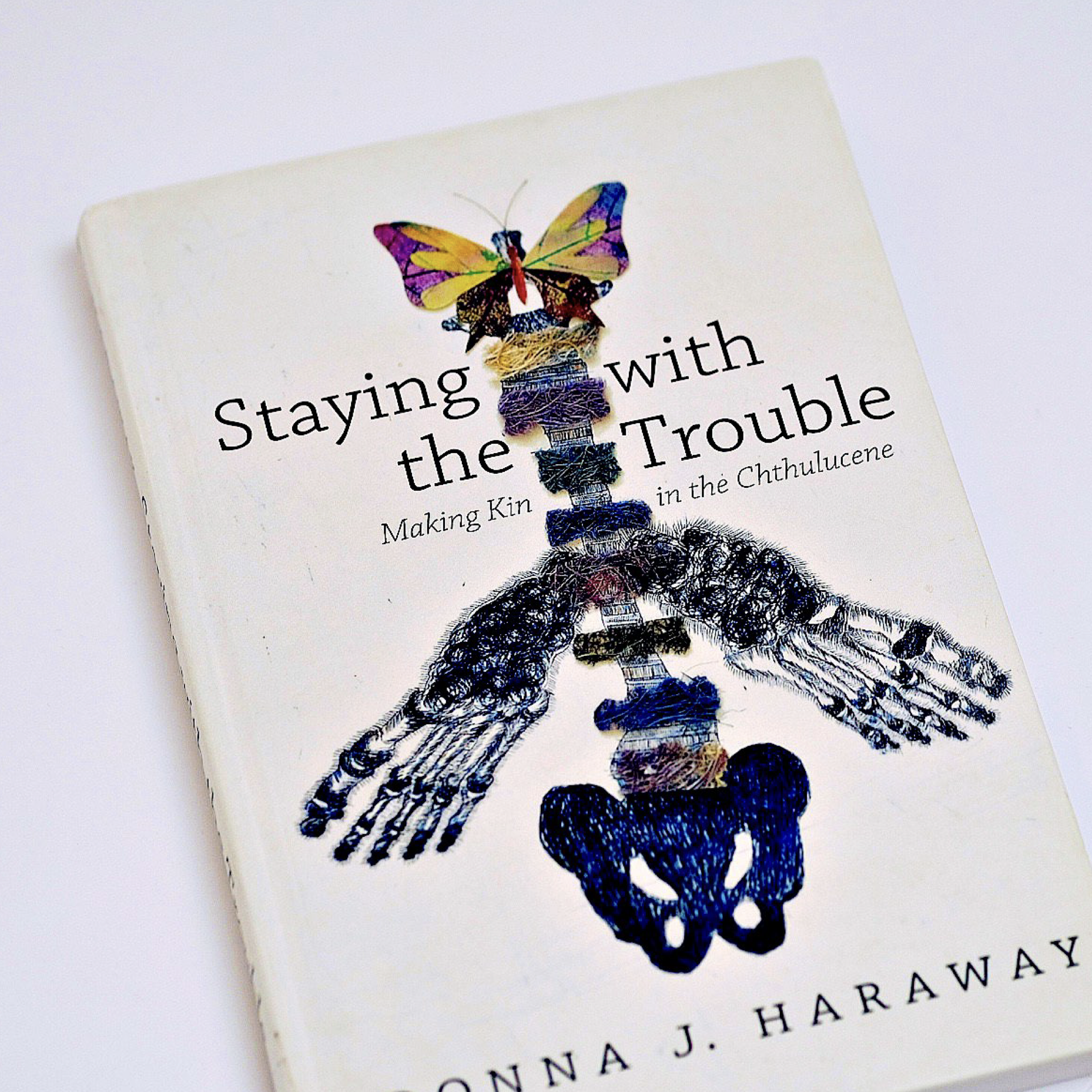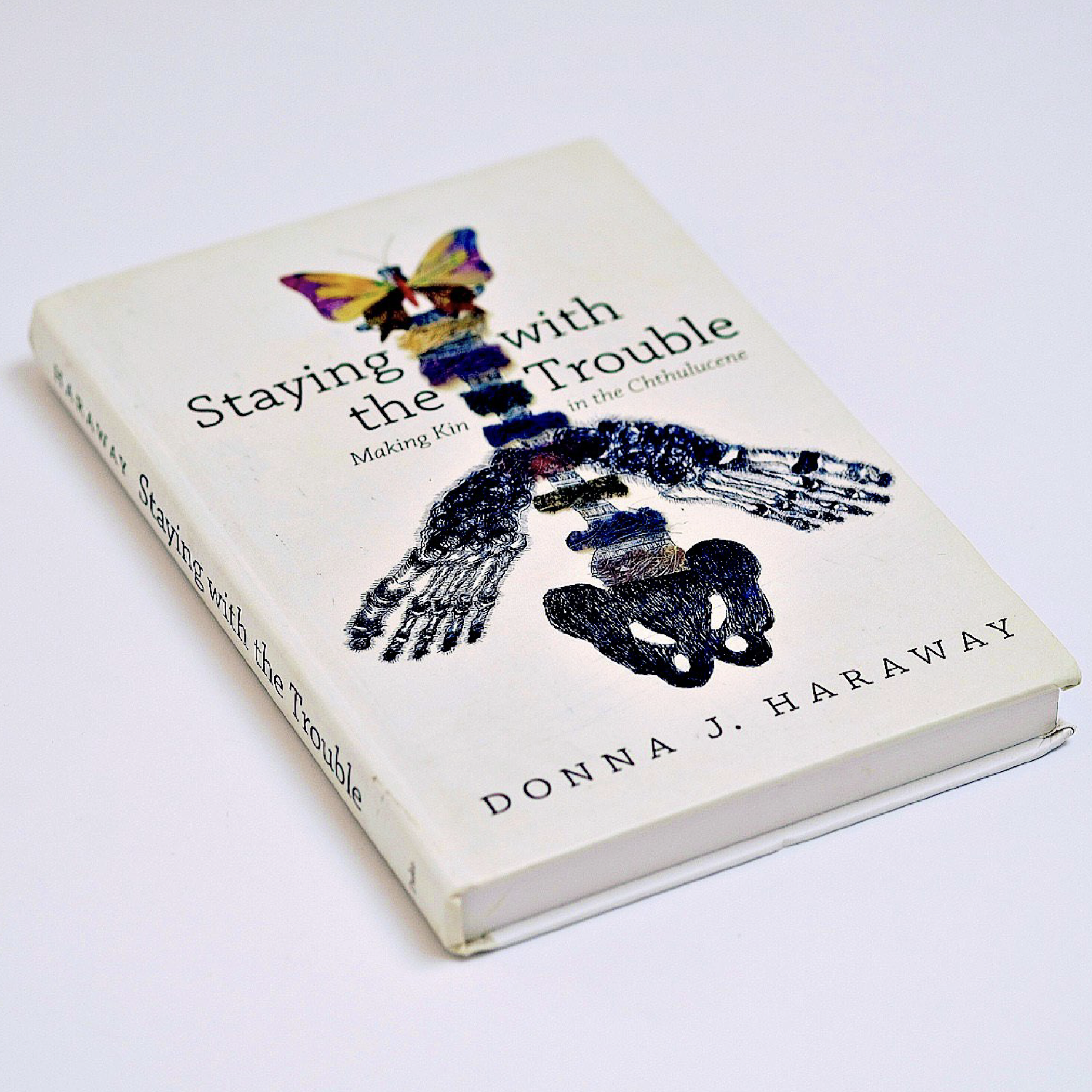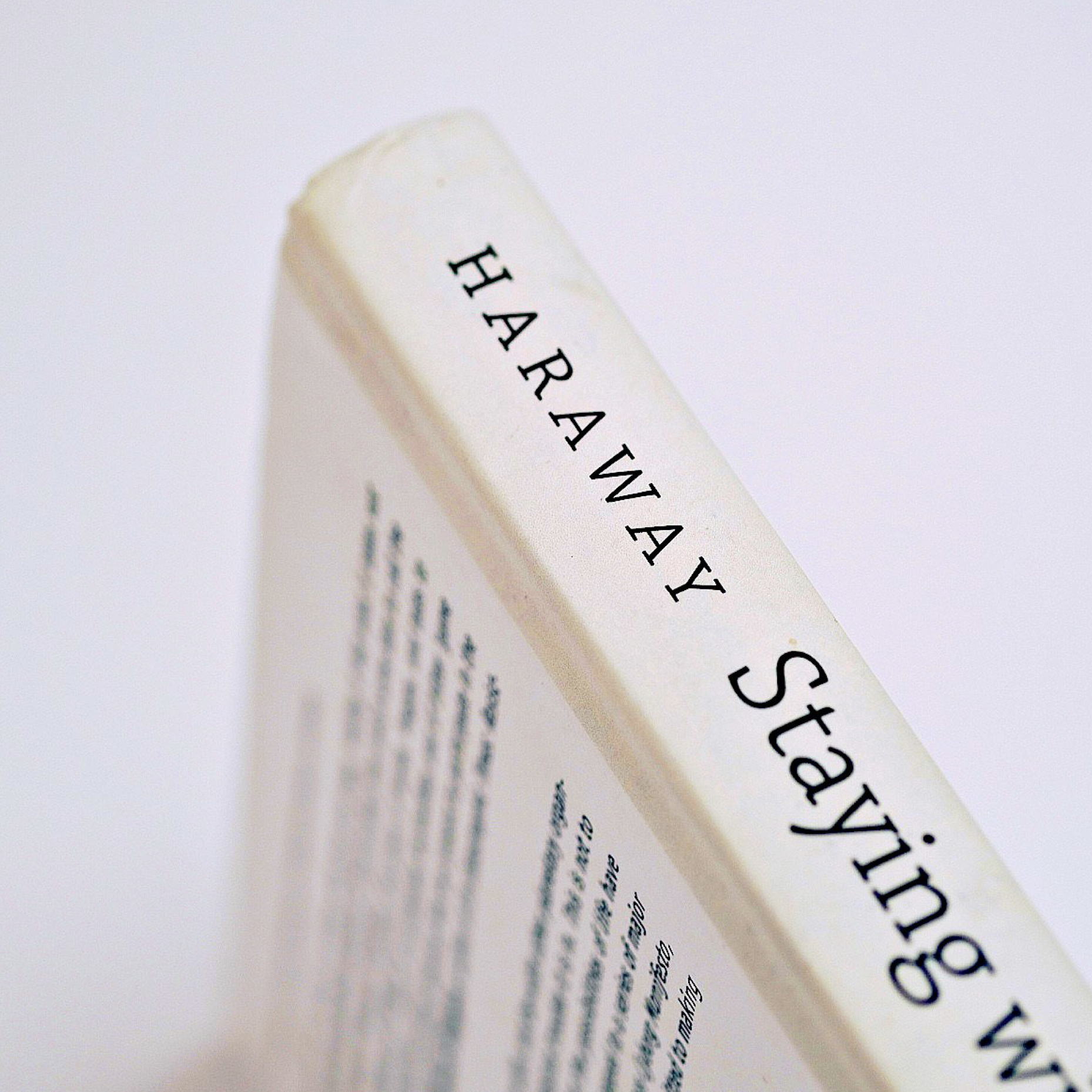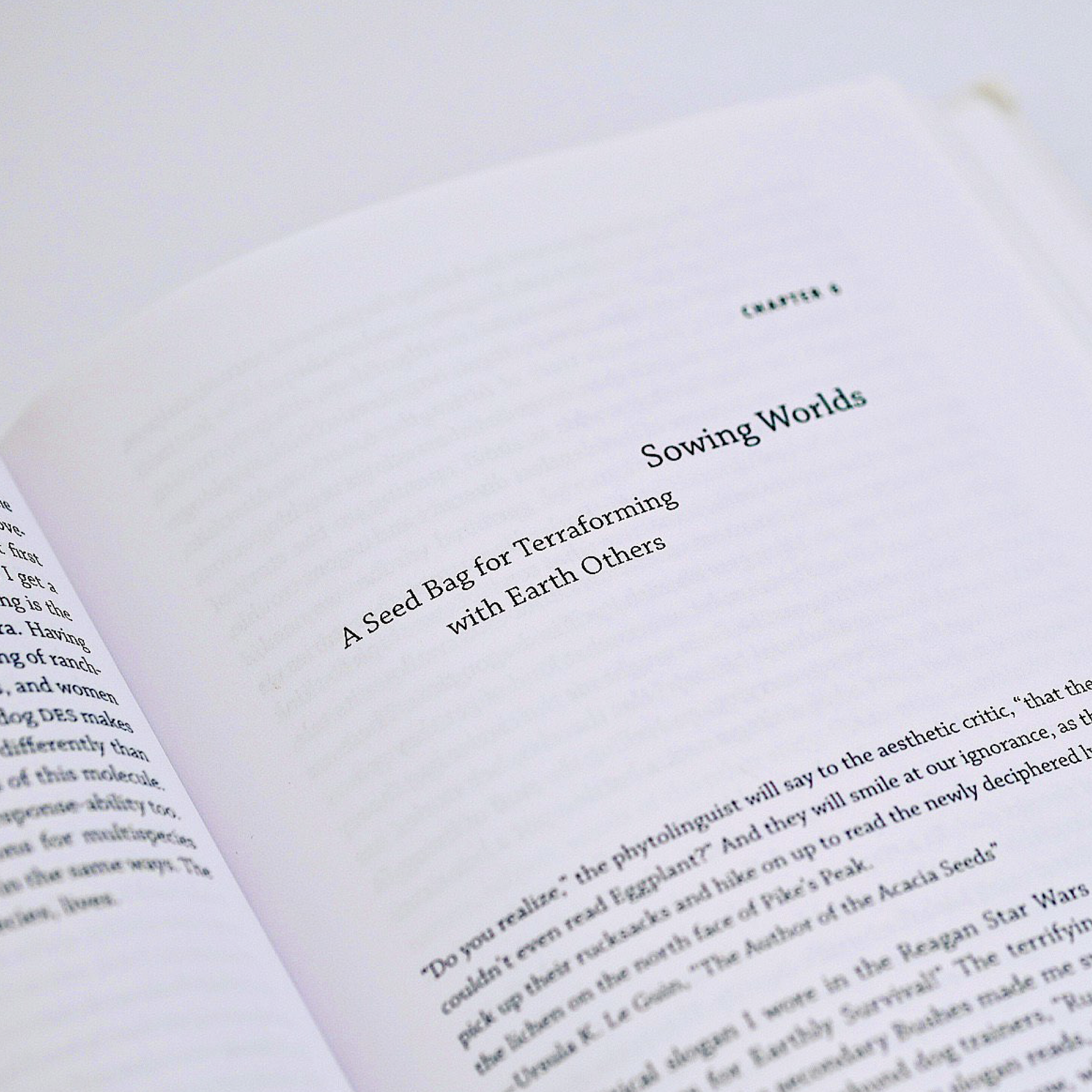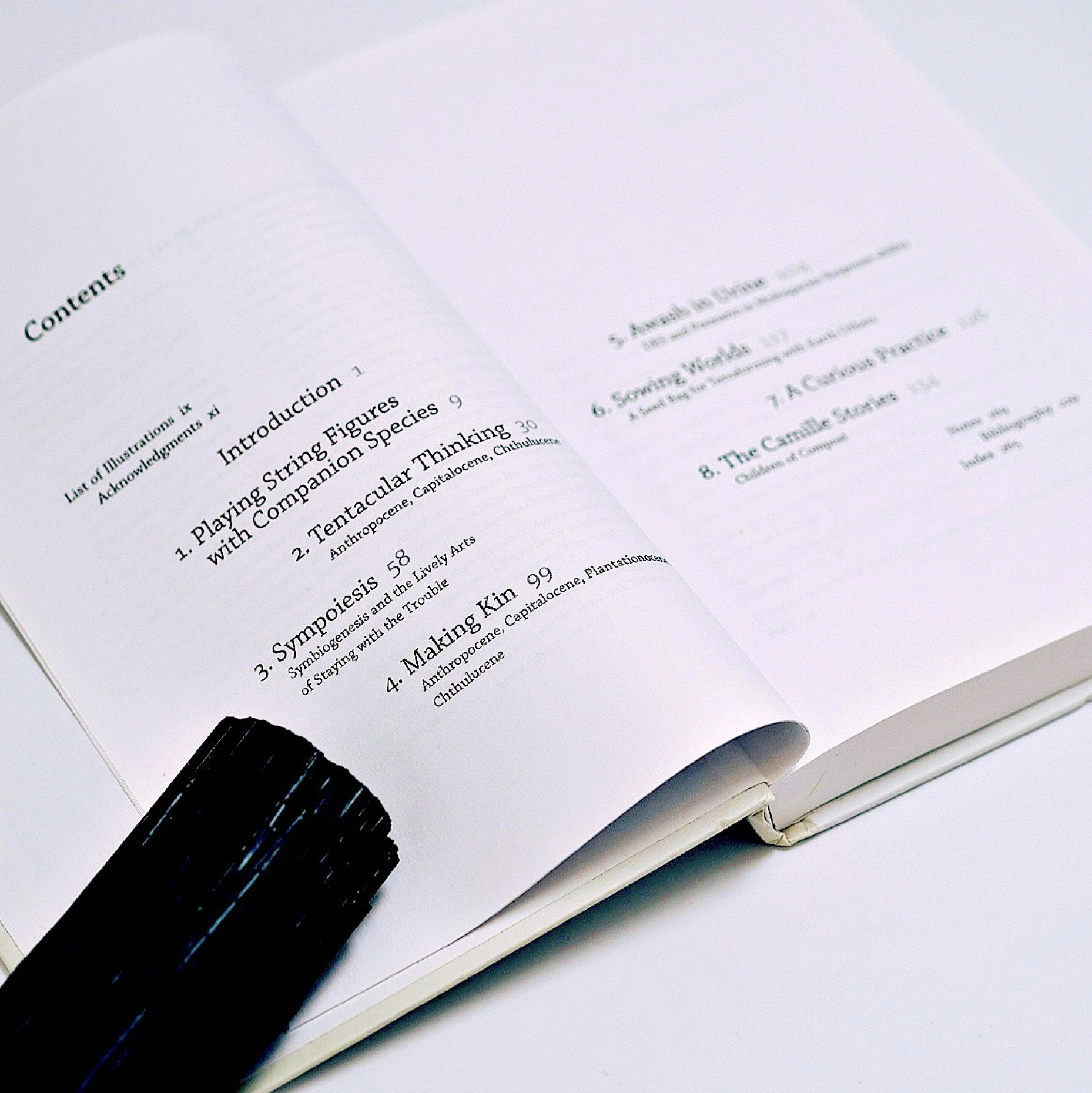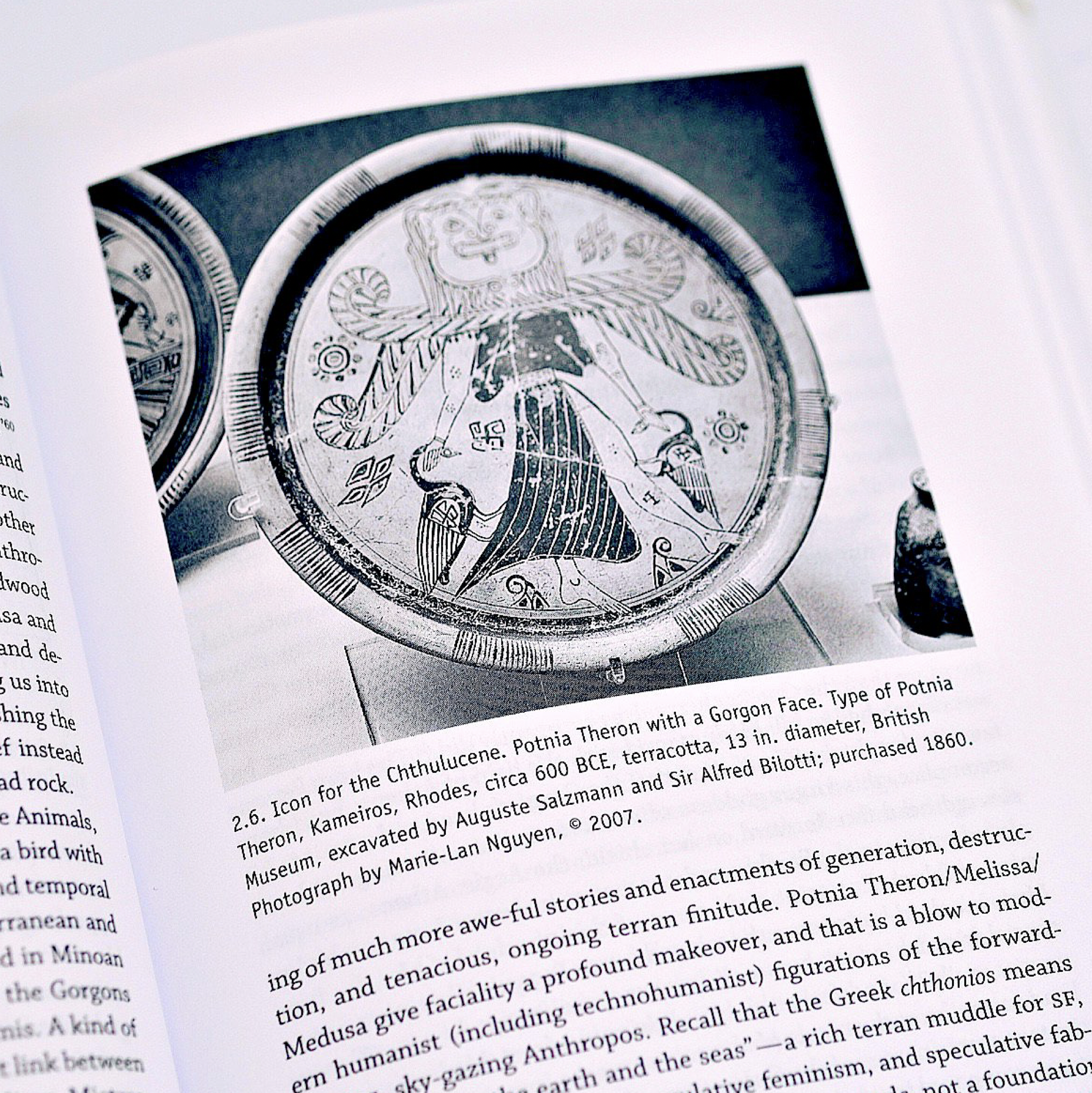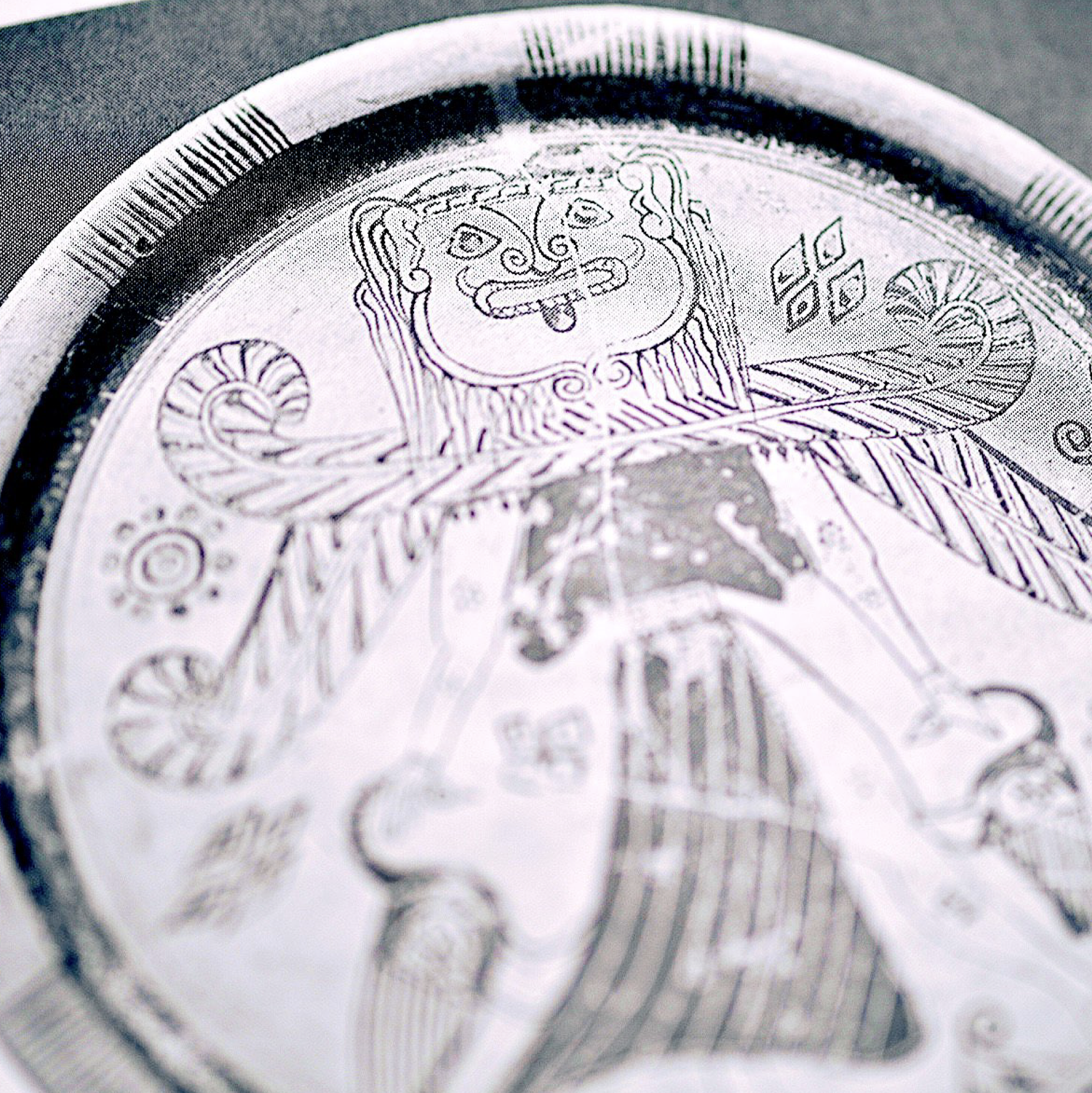‘Staying with the Trouble: Making Kin in the Chthulucene’ by Donna J. Haraway
Review: Donna J. Haraway; Staying with the Trouble: Making Kin in the Chthulucene, Durham and London: Duke University Press, 2016, ISBN: 9780822362241
To read a work on multi-species response-ability, mutual flourishing, and making-kin, one must have some sort of reason to join Donna J. Haraway in examining the links between pigeons and humans, or the way Native American games and practices of weaving relate to the kinship between horses, an ageing woman and her dog, and urine – as but one example.
Some sort of reason for following the works of Science Fiction/ Speculative Fiction luminaries Ursula K. Le Guin and Octavia E. Butler as they thread through and enliven Haraway’s prose – the carrier-bag, woven in its many ways, in distinction to stories of violence and individual autonomous heroes. The blending and merging and becoming-more-than, different-to, the anthropos – the human – which renders itself at the centre of everything.
This is the reason behind the book’s subtitle: Making Kin in the Chthulucene – taking us beyond the anthropocentric creation of the so-called Anthropocene.
This name for a geological and climatological epoch has achieved currency lately; the idea that humans have changed the planet so much that it deserves naming, acknowledging – and perhaps grieving.
Here at Paralibrum one of the more recent reviews has been of a new book which draws on and acknowledges the influence of this book, and so it seems apt to examine one of its source texts, because digging down to earth and seeing what one finds is ever interesting.
After all, before Hogwarts and Harry Potter gave us an enervated shade of the Scholomance by way of the idealised British Public School fiction genre and its attendant imperialist ghosts, there was another.
Specifically, there was the Archmage Ged, and the wizard school of Roke, in Le Guin’s A Wizard of Earthsea, first published in the US in 1968. Leaning heavily on a Taoist-style cosmology for its coming-of-age narrative, rather than that of a Chosen One battling and triumphing over an evil foe, the first of the Earthsea novels has Old Powers, necromancy gone awry, and of course, the requisite dragons.
While Earthsea is not mentioned in Staying with the Trouble – Haraway references Le Guin’s Hainish Cycle regularly – it is perhaps a better entry point for those of us reading this review as, whether one bears the sobriquet of wizard willingly or not, the notion of magic-as-influence in-and-with-the-world piques our interest. Whether that is enough for you to trouble yourself with this review, only you can judge.
Perhaps this preamble has convinced you to stay with it; this reviewer makes no apologies for the foregoing. Trouble is, as Haraway says, an interesting word:
It derives from a thirteenth-century French verb meaning “to make cloudy”, “to disturb”. We – all of us on Terra – live in disturbing times, mixed up times, troubling and turbid times. The task is to become capable, with each other in all our bumptious kinds, of response. […] The task is to make kin in lines of inventive connection as a practice of learning to live and die well in a thick present. […] Staying with the trouble does not require […] a relationship to times called the future. In fact, staying with the trouble requires learning to be truly present, not as a vanishing pivot between awful or edenic pasts and apocalyptic or salvific futures, but as mortal critters entwined in myriad unfinished configurations of places, times, matters, meanings. (p. 1)
The above quote is Haraway’s central thesis, with “critters” serving as a naming convention for entities on Earth, or as Haraway has it, Terra. Much like how the word wight in older versions of English included all forms of agential beings, rather than solely some sort of spirit, as Tolkien himself knew when he wrote of barrow wights in Lord of the Rings – the word “critter” goes beyond the human. Indeed, it subtly undermines the division between human and otherwise.
Haraway’s book itself is rather short – only 168 pages of front-matter in this paperback edition. However, with 60 pages of chapter notes, a 36-page bibliography, and a 32-page index, totalling 128 pages of back-matter, there should be an indication of the density involved. If nothing else, this book is a treasure-trove for those who like to go spelunking in the wilds of philosophy, ecology, history, and science.
Spread over eight chapters, with the first three being of greater length, Haraway’s weaving and knotting together of seemingly disparate entities into a relational kinship framework is, to use the author’s own coinages “sympoiesis” with “oddkin” – that is, a making-with, or a bringing-forth-with.
Chapter 1 is entitled Playing String-Figures with Companion Species. Chapter 2, Tentacular Thinking, Chapter 3, Sympoiesis, Chapter 4, Making Kin, Chapter 5, Awash in Urine, Chapter 6, Sowing Worlds, Chapter 7, A Curious Practice, Chapter 8, The Camille Stories.
This reviewer has elected not to share the subtitles of these chapters deliberately, both for reasons of length but also to allow the reader to seek them out if interested – this is not a blow-by-blow review after all, but more an overview of the whole spectacle.
Nowhere in this work is anything alone. The dividing lines between entities are rendered “promiscuously” porous.
Pigeons and their fanciers; the cityscapes and landscapes they fly over; the prevalence and preponderance of maleness in the pigeon-fancier communities; the magnetic sense, homing and what constitutes home; the place of art, science, data, and aesthetics; all these are given a relationality in the first chapter, as an example.
In some senses, this relationality is explicitly theoretical, that is, in a technical and literal sense. Rather than mere abstraction, the examples and sympoieticisms of each chapter serve as explorations of how one might begin to sense the world in the Chthulucene. Not in the notion of a how-to, but rather each chapter as a broad slice of cosmogony. By this the reviewer means a kind of modelling-how-to-model: specifically in the sense of θεωρία (theoria).
Theoria is a viewing, a witnessing, a spectacle, a contemplation of what-is, to participate as-spectator in a sight. A wit(h)-ness-ing in a sense.
Haraway invites us, as readers, to spectate-and-speculate with the experiences she records and links together. It is not passive, but a participatory role which invites us to speculate-with-Haraway about our own experience. We are presented with the author’s oddkinnery and perhaps may begin to conceive of ourselves tentacularly; touched, grasped, tasted-with, made and making-with things beyond the boundaries of what we consider human or person in our lives.
As practitioners we dismiss “mere theory” at our peril. As an example, how much our so-called Western Magical Tradition depends on the theories of Plato, with the realm of Forms a kind of emanationism from “On High” that remains unexamined, but still de rigueur in many quarters?
This question is not rhetorical – much has been written in the 21st century on the influences of the Ouranic/Olympic/High/Upper World ideal as dominant structure in magic, and the subsequent denigration of the Tellurian/Chthonic/Low/Underworld. That these influences often remain uncontemplated is something Haraway – though not a magical practitioner as far as this reviewer knows – is also concerned with.
Indeed, this is the reason behind the coining of the term Chthulucene. While acknowledging the Lovecraftian fictional deity and its tentacles, Haraway makes pains to spell it differently in an effort to return to the roots which gave that monstrous eldritch entity its name. To wit, the author derives it from kthôn and kainos:
Together [they] name a kind of timeplace for learning to stay with the trouble of living-and dying on a damaged earth. […] Nothing in kainos must mean conventional pasts, presents, or futures. There is nothing in times of beginnings which insists on wiping out what has come before or indeed wiping out what comes after […]
Chthonic ones are beings of the earth, both ancient and up-to-the-minute […] replete with tentacles, feelers, digits, cords, whiptails, spider-legs and very unruly hair. Chthonic ones romp in multicritter humus but have no truck with sky-gazing Homo. Chthonic ones are monsters in the best sense […] [they] demonstrate and perform consequences. Chthonic ones are not safe; […] they writhe and luxuriate in manifold forms and manifold names in all the airs, waters, and places of earth. (p. 2)
As we can see by this evocative passage, Haraway is extremely earth-centred in this book, and as such falls into a kind of binary issue wherein the earth tends feminine and thus heavens are masculine. Obviously, she is not the first to fall into this dualism – it’s a long-standing form of thinking. However, we should also not forget the roles of the myriad Queens of Heaven, nor should we conceive of star-gazing as the sole preserve of Homo. There is, of course, an equally longstanding myriad of broad cosmovisions wherein the heavenly bodies such as the sun, moon, and stars – not to mention the planets – are conceived as being within a starry cavern.
In this sense, we might once again borrow from Lovecraft and use the possibility of the Chthonic ones as some form of star-spawn without falling prey to some kind of ouranic/ emanationist paradigm or fallen angel narrative. – The swimming-flying-writhing-betweenness works just as well when the depths and gulfs of the heavens are evoked, at least as far as this reviewer is concerned.
Here too, it is important to note that the visions, the spectacles which Haraway presents are not models-as-tracking or tracing. Nor are they mere mappings or schemata, but as alluded to above, things in themselves which generate response. As Haraway says, quoting British social anthropologist Marilyn Strathern: “it matters what ideas we use to think other ideas (with).” (p. 12)
For those of us familiar with the dictum of Korzybski in which “The map is not the territory” this may at first glance seem queerly familiar, since the way we perceive the world is not reality itself. Yet Haraway links SF to worlding – whether this be the worlds of Le Guin or Butler or others.
Worlding is, it appears, sympoietic, and so in the making, we are also being made. That is, the idea of a sole mapmaker is incorrect. As author and Nigerian public intellectual Bayo Akomolafe puts it, we need a “thicker we”, precisely because the processes of SF, of theoria, which are relational.
Thus, the map may not be the territory, but this is to be understood on a deeper level than is usually considered by most who trot out the Korzybskian phrase. The worlding makes us –we are critters made by, and with, other critters.
It matters what ideas we think and believe with, not only because it shapes our ability and methodology and kin(d) of response-ability, but also because “we” is broadened.
In a magical cosmovision of inter-and-intraweaving, the notion that an individual can be isolated, atomised or defined as singular, uninfluenced or untouched by the myriad Powers and Presences of the cosmos seems strange to this reviewer.
So, it matters, precisely because of materia, whatever that may be. Vision and dream become potent and oracular once more; portentous processes that overflow the personal, instead of being regarded as individualised nocturnal junk-sortings.
A dream you have may not be for you, but part of an assemblage. How you are responding to something seemingly irrelevant, pointless, may indeed induce a ripple, a writhing, in this thick, fluxing, vital cosmos.
Mentation, word, body, gesture, name – Le Guin’s Earthsea speaks deeply about the magic of True Names, after all. He who becomes Archmage Ged was known by several names, including Duny and Sparrowhawk. Each of these had meaning, resonance – they were not placeholders for the True Name.
It matters what matters we use to think other matters with; it matters what stories we tell to tell other stories with; it matters what knots knot knots, what thoughts think thoughts, what descriptions describe descriptions, what ties tie ties. It matters what stories make worlds, what worlds make stories. (p. 12)
Ged truly becomes Archmage in Earthsea when he embraces the Other, when his ‘I’ thickens and becomes ‘we’ and the Power he allowed into his world through necromancy, which has hunted him all across the Archipelago, has become part of him, and he part of it. It is only then that he resonates, is in concert with the weavings of the world, where previously one might say there was a great rent.
It is in response that we are in some sense, already overcome.
For this reviewer, this is where the flaw in Haraway’s work lies, both in this text and her earlier Cyborg Manifesto (in: Donna Haraway; Simians, Cyborgs, and Women – The Reinvention of Nature, Abingdon-on-Thames: Routledge, 1991 [1985], ISBN 9780415903875). We have already seen that she repeatedly refers to becoming capable of response-ability. Her SF worlding throughout the text, her multi-species flourishing and relationality which crosses traditional boundaries of selfhood, all these are conceived of as weavings and blendings perceived consciously, enacted consciously by a human. Intimations of breaking, failure, incapacity, debility, or lack of perceived success and its metrics are rarely discussed, at least here.
The spectacle, the viewing, the witnessing, the response – all these are deliberate foci, supposed recognitions and worldings of relationality. That they may pre-exist her presence never seems to be deeply considered.
Kainos can be full of inheritances, of remembering, and full of comings, of nurturing what still might be. I hear kainos in the sense of thick, ongoing presence, with hyphae infusing all sorts of temporalities and materialities. (p. 2)
If it matters what matters we think other matters with, then the influence of the Other on the speculative fiction must be considered. Haraway’s cosmovisions do not seem to consider the occult or occluded, the unconscious, the unknowing processes. That is, she evokes Butler and Le Guin, and with them sings the praises of change, but it seems only to be a particular kind of change, conscious, wilful, and able.
Haraway says:
Think we must; we must think. That means, simply, we must change the story; the story must change. Le Guin writes, “Hence it is with a sense of urgency, that I seek the nature, subject, words of the other story, the untold story, the life story.” (p. 40)
Haraway writes that Le Guin taught her the carrier bag theory of storytelling, and that this is in contra-distinction to
[a] tragic story with only one real actor, one real world-maker, the hero, this is the Man-making story of the hunter on a quest to kill and bring back the terrible bounty. This is the cutting, sharp, combative tale of action that defers the suffering of the glutinous, earth-rotted passivity beyond bearing. (p. 39)
Clearly Haraway is against such a singular story – the whole premise of her work is embracing the multiplicity of kinship. Yet, let us return to Le Guin, who is quoted again:
A leaf a gourd a shell a net a bag a sling a sack a bottle a pot a box a container. A holder. A recipient. (quoted, Ibid)
Bear this in mind, as Haraway brings in Octavia Butler, later on in the book:
In the Parable novels, “God is change.” and Earthseed [an organisation in the novels] teaches that the seeds of life on Earth can be transplanted and can adapt and flourish in all sorts of unexpected and dangerous times. Note “can”, not necessarily “may” or “should”. Butler’s entire work as an SF writer is riveted on the problem of destruction and wounded flourishing – not simply survival – in exile, diaspora, abduction, and transportation – the earthly gift-burden of the descendants of slaves, refugees, immigrants, and the indigenous too. It is not a burden that stops with settlement. (p. 120)
This wounded flourishing, these stories of the overcome-and-overcoming are vitally important, and yet it seems as if Haraway’s notions of capability and response-ability might be closer to the Man-making story (in the sense of making, worlding Mankind, but also possibly Western modern constructions of masculinity, agency, grasping, and potency) than she may consciously be aware of.
Consider, again Earthsea, where Sparrowhawk the student is learning from Master Hand:
But you must not change one thing, one pebble, one grain of sand, until you know what good and evil will follow on that act. The world is in balance, in Equilibrium. A wizard's power of Changing and of Summoning can shake the balance of the world. It is dangerous, that power. It is most perilous. It must follow knowledge, and serve need. To light a candle is to cast a shadow. (Ursula K. Le Guin, A Wizard of Earthsea, Berkeley/CA: Parnassus Press, 1968)
How then, do the wizards of the isles justify their magic? Surely, some argue, Hand, and by extension Le Guin, is arguing for careful maintenance of the Equilibrium, i.e. the status quo?
Perhaps it may help us to consider that the world of Earthsea is just that, a world of Earth and Sea. Ged spends much of the book (and subsequent novels in which he appears) sailing.
Via usage of magic and knowledge, sail and wind and current, he navigates. But not a straight line. Never in a linear, direct fashion. He steers his little boat, even as Archmage, at the mercy of the world. He continues to exist at the mercy of the world. Following knowledge, and serving need. His coming of age is rife with failures, and in being overcome. He learns sympathy, receptivity – to be a recipient – and even to exist without magic when it is needful.
This a fundamentally Taoist vision in a sense, to cultivate the faculty to do without doing, to act without acting and, in being so operate in a kind of flourishing which acknowledges that it is not individual agency that is important but being in accord with some sort of cosmic vitality – the God, the T/Dao, which is change. This is the untold story, the life story which Le Guin sought, always fugitive, ever over-flowing the boundaries of the container which was shaped to receive it. It is no coincidence, or surprise, that Le Guin produced her own translation of the Tao Te Ching when you look at her SF.
There is always an unintelligibility, a mystery hidden within the matter that matters, an elemental unseen which, far from being distant, remains terribly, awfully in pursuit. Who is the hunter, and who the hunted? If God is Change, then that binary becomes a polarity, a whirling yin-yang, an eternal mountain that has a shady side and a sunny side revealed by sympoietically made by-and-with the shifting patterns of the weather. The Tao that can be spoken is not the Tao.
Haraway writes:
In the SF mode, my own writing works and plays only on earth in the mud of cyborgs, dogs, acacia trees, ants, microbes, fungi, and all their kin and get. (p. 120)
This sounds good, until you begin to realise that Haraway is, to some extent, incorrect about her own work. Since 1985’s Cyborg Manifesto, when she wrote that “we are all cyborgs”, it appears she has consistently failed be present for them, to stay with their trouble.
As the Cyborg Jillian Weise writes in cy’s essay Common Cyborg:
To Haraway, the cyborg is a matter of fiction, a struggle over life and death, a modern war orgy, a map, a condensed image, a creature without gender. The manifesto coopts cyborg identity while eliminating reference to disabled people on which the notion of the cyborg is premised. Disabled people who use tech to live are cyborgs. Our lives are not metaphors.
Disabled women, Deaf women and neurodivergent women are never mentioned in the ‘Cyborg Manifesto’, which is strange, because the manifesto is full of appellations that have been, historically, applied to us (such as ‘monster’ and ‘creature’).2 Haraway does gesture briefly toward the 1969 novel The Ship Who Sang by Anne McCaffery. The premise of the novel is that parents of children with disabilities may choose to stunt their growth, contain them in a titanium shell, and plug their brains into circuitry. In 2004, the parents of a six-year-old white disabled girl, named Ashley X, ordered her hysterectomy, the removal of her breast buds and an appendectomy. This would make it easier for her parents to care for her, relieve her of menstrual cramps, prevent pregnancy and remove the threat of sexual abuse by caregivers. Her parents consider the treatment a success. First we read about this in a sci-fi novel, then in a feminist manifesto, and finally in the medical journals.
Haraway’s own words again:
It matters what matters we use to think other matters with; it matters what stories we tell to tell other stories with […] (p. 12)
Nor is cy the only one to make this point. Academic philosopher Damien P. Williams, soon to take up post as Assistant Professor of Ethics & Data Science at UNC Charlotte, writes that Haraway:
[C]ame to use the notion of the cyborg as a way to describe how human lives may become entangled with nonhuman entities and systems […] seeming to conceive of “disability” as a singular category rather than the multiform variable conditions that can be linked under this label. (Heavenly Bodies: Why It Matters That Cyborgs Have Always Been About Disability, Mental Health, and Marginalization)
Cyborgs are kin, whelped in the litter of post-World War II information technologies and globalised digital bodies, politics and cultures of human and non-human sorts. (p. 104)
Haraway says that “Cyborgs matter in terran worlding.” (p. 105).
Yet nowhere in that 32-page index of Staying with the Trouble is there an entry for disability. Nowhere is mentioned the spaceflight origin of cyborg-as-term as outlined in Williams’s work.
One wonders if such a sky-god-realm origin is simply ignored as inconvenient?
Of course, all authors are allowed their biases and lacunae. It is impossible to cover all the bases. Yet with her personal emphases it seems odd to this reviewer that, if Haraway is only speaking of the cyborg in the narrower sense as a term of art, it is never mentioned as that. Instead, it seems to be spoken of in an all-encompassing sense. This, combined with her emphasis on activity, capability and response-ability seems somehow telling, as if the SF she is worlding is perhaps less about the earth itself, and more about the surface of it, which may be traversed by upright, two-legged means.
Where, dare this reviewer ask, is the becoming-with-monsters, those bodies crippled, crooked and bent, dis/abled, weighed down with the weight of late-stage capitalism, those wounded and ill who have nonetheless flourished under care and the very processes she speaks of since at least Neanderthal times, communities engaging in matters of care and attention with each other, their elders, ancestors, descendants and those yet to be, as well as those other than human? How else did the companion animals she speaks of come to live-with-us, at the very least?
It strikes this reviewer that Haraway is concerned with her own playground, alone, in this book. In somehow bringing forth with-the-earth without consideration that her worlding is one which is less grounded than many, less earthy, messy, and indeed more rarefied than most:
Marx understood all about how privileged positions block knowledge of the conditions of one’s privilege. So did the innovators of feminist standpoint theory, the founders of the women’s health movements and the thinkers and activists shaping movements for animal flourishing. […] I did not conjugate well with the horses themselves. Shame is a prod to lifelong rethinking and recrafting one’s accountabilities! (p. 111)
Perhaps so. Does all this invalid-ate (pun intended) Haraway’s work, and the book in general? This reviewer thinks not – her failure, rather than her response-ability – has generated fertile responses in the six years since Staying with the Trouble was published. Her speculative fictions have been critiqued, salvaged, and the useful bits gathered up in the very same bag and shared amongst many unlike (and also like) her.
To quote Bayo Akomolafe again: “What if the way we respond to the crisis is part of the crisis?”
For the wizards amongst us then, perhaps we might say that, like much SF, the fiction may draw our attention to the reality of the Mysteries and unknowns from which it emerges.
To descend into the earth is to dream amongst serpents and dogs and gods and Titans. To enter the turning-point of dis-ease and be turned further downward and to be rendered lost and led down the labyrinthine path of mutual flourishing, to where our blood flows beyond and into the more-than-human via pact, song, ritual, and overflowing libation.
A path which demands an openness to being over-come and going-under, flowing through many shapes, and conjuring-with, conjugating-with – to sailing the seas of the numinous, following unseen currents of vitality, of life.
May Ursula and Octavia guide our ways, even if Donna may, for whatever reason, not do so.
